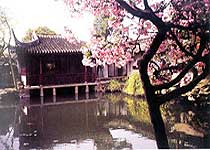Attration Category
Suzhou Weather

Sometimes the smallest package can contain the most magnificent gift. The Garden of the Master of the Nets is a clear example of this. It is the smallest of the Suzhou residential gardens, yet it is the most impressive because of its use of space which creates the illusion of an area that is much greater than its actual size. Even more than the architectural achievement is the mood of tranquility and harmony that this humble garden embodies.
This exquisite garden was first designed during the Song Dynasty (960 - 1279) as part of a residence that was used until the Taiping Rebellion in the 1860's. It was later restored and became the residence of a government official from whom the garden got its name. It is said that in a moment of frustration with bureaucracy he declared that he would rather be a fisherman than a bureaucrat.
The garden is divided into three sections: a residential section, the central main garden and an inner garden. The main garden has a large pond that is surrounded by pathways and a variety of buildings such as the Ribbon Washing Pavillion, and the Pavillion for the advent of the Moon and Wind. There are many more buildings that are situated so that there is never a sense of crowding, but always of spaciousness. As is common in Suzhou gardens, the pond has a small pavilion in it. Here the pavilion is accessible by a bridge that is less than one foot wide.
As you walk about the gardens and along the walkways, there are often views through windows onto beautiful flowers or plants framing them from a distance and drawing you to a single sight, a moment of peaceful natural beauty. As you walk through the buildings, it is easy to imagine the life that the original residents lived in a feudal society where these gardens were solely for their pleasure and the pleasure of their guests. The various buildings are constructed so that you can always access the main garden from any room. The rooms themselves are quite impressive in design and ornamentation and well represent the style of the Song Dynasty.
The inner garden which is only about 660 square feet, has the distinction of being used as the model for the Ming Hall Garden at the Metropolitan Museum of Art in New York City and also completely miniaturized for an exhibit in the Pompidou Center in Paris in 1982. This garden is reputed to be the most well-preserved garden in Suzhou and should not be missed. It is small in size, but is like a beautifully cut diamond whose beauty is of never ending fascination and pleasure.


